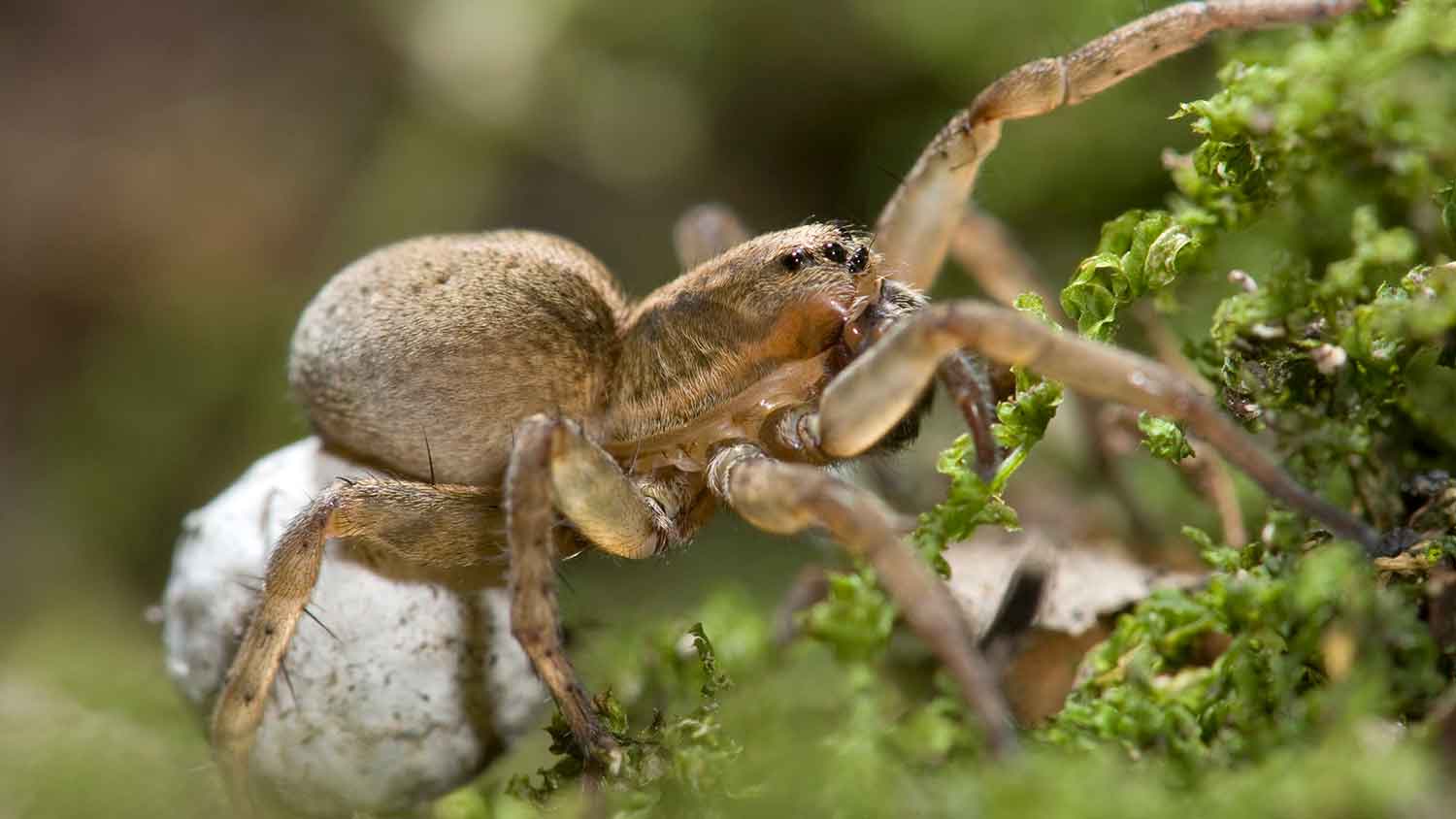
Whether you have bugs, bats, or rodents invading your home, you’ll want to contact an exterminator quickly. Find out how much pest control costs in Columbus, OH.
If you come in contact with either of these, you’ll appreciate knowing the differences


Wolf spiders have eight larger eyes and often have stripes, while a brown recluse spider has six smaller eyes and a dark brown violin-shaped marking.
Brown recluse spiders are found in the south-central and Midwestern states, while you can find wolf spiders almost anywhere in the U.S.
Both spiders have venomous bites, but wolf spiders are generally less dangerous.
If you’ve heard horror stories about the victims of brown recluse spider bites or local legends about the big, bad wolf spiders that actually eat these venomous villains, then you probably want to know how to spot them. These arachnids sound scary, but both creepy crawlies want as little to do with humans as we do with them. They may set up shop in your basement, but they mean you no harm. Nevertheless, here’s how to distinguish brown recluse vs. wolf spiders, so you can peacefully stay out of each other's way.
You may lump all spiders together, but these species have their own distinct characteristics.
| Characteristic | Brown Recluse | Wolf Spider |
|---|---|---|
| Size | 1/4 to 1/2 inch | 1/2 to two inches |
| Color | Tan to dark brown | Brown to gray |
| Preferred environment | Dark, dry, quiet | Woods, fields, coast |
| Number of eyes | Six | Eight |
| Venomous bites | Yes | Yes |
| Life-threatening bite | Yes, seek help | Unlikely |
| Behavior | Shy | Can be aggressive |
| Web | Yes | No |

First, you need to know how to identify these spiders on sight.
A brown recluse spider is smaller than a wolf spider. Without the legs, the body of a brown recluse measures about one-quarter to half an inch in size. When they extend their legs, they reach the size of a 25-cent coin.
Wolf spiders range in size since there are over 2,000 species of this particular spider. However, most are on the small side, ranging from a half-inch to two inches, and they have longer legs than a brown recluse.
Neutral coloring is essential to many spiders who rely on soft shades to blend into their surroundings. A brown recluse is often light to dark brown, and wolf spiders vary in color but stick to neutral tones like tan, gray, and brown. These two spiders have distinct markings that can help you identify them should you get close enough. Brown recluse spiders are also known as fiddlebacks because of their signature marking—a dark brown violin shape you’ll see on their back. Wolf spiders also have distinctive markings on their backs, usually in the form of stripes.
Admittedly, you don’t want to get close enough to count the number of eyes a spider has, but it offers a major clue for identifying a brown recluse versus a wolf spider. A brown recluse has six eyes arranged in three groups of two. Wolf spiders have eight eyes—two in the front, two more at the top of the head, and four right above their mouths.
Another big difference between brown recluses and wolf spiders is where they live and their preferred environments.
You’ll find brown recluse spiders across a large portion of the U.S., but they are typically more popular in the Southeast and Midwest regions. They can live as far south as Georgia, all the way up to Ohio, and west to Texas.
Because there are so many species of wolf spiders, you’ll find them spread across the whole country. However, you might find a particular species of wolf spider more concentrated in certain states.
Brown recluse spiders like warm, dark, dry spaces. Because of this preference, you’ll find them in basements, closets, and wood piles—any place they can hide.
Wolf spiders are at home in the woods and can adapt to different habitats. From coastal forests and alpine meadows to urban areas, gardens, and inside your home, they’ll be wherever they can find prey.

While they share some physical characteristics, the behavior between brown recluse and wolf spiders couldn’t be more different.
Like the name suggests, brown recluse spiders are more reserved and prefer spaces where they can hide out. Though many people fear them for their dangerous bite, they’re not aggressive spiders. When these spiders bite someone, it’s usually a defense against being stepped on.
The wolf spider gets its name from prowling around and hunting for prey, but it’s not typically aggressive towards humans. However, this doesn’t mean they won’t bite you—but fortunately, their bites aren’t particularly dangerous.
The brown recluse spins a web, which they use for catching prey like insects. You’ll find these webs in places where they’re undisturbed, such as your basement or attic. Wolf spiders do not spin webs, though. Instead, they hunt their prey or catch bugs as they pass by.
One of the most fascinating traits of a wolf spider is how the females carry their egg sacs on their backs. These sacs can contain over a hundred eggs. During this time, they can become more aggressive, so take caution if you happen to notice an egg sac.
The first thing you may be concerned about with these spiders is the danger of their bite. Thankfully, their bites are rarely deadly.
Both the brown recluse and wolf spider have venomous bites. They need this venom to survive because it kills their prey. However, the venom of a brown recluse is more potent than a wolf spider’s. It’s also worth noting that due to their small size and tiny mouths, they can’t deliver much venom in a single bite.
The good news is that while wolf spider bites can be painful and produce some swelling, they are typically considered harmless for humans.
Venom from a brown recluse bite, however, can be dangerous to humans. Common symptoms of a brown recluse bite are redness, pain, and open sores at the site that can take months to heal completely. Some people even experience systemic reactions to this venomous bite, which in rare cases, can be deadly. If you suspect a brown recluse spider has bitten you, seek medical attention immediately. A brown recluse making a home for itself in your house can be a problem too, and you might want to accept the cost of pest control and hire a local exterminator to deal with the problem before it gets out of hand.
This company does it right. Firstly, I want to say that Landan was a joy to work with. He was so kind, transparent, and had everything under control. His entire team showed up ready to work and they were all very respectful of the fact that we were in an office space. A little backstory – we...
Our office has a new lease on life, thanks to Custom Paint Jobs LLC. Outstanding work!
Window Depot did an amazing job on my deck. I wasnt sure what I wanted to do, but their composite decking was affordable and will last a long time. I am excited to have family over, and I am no longer embarrassed by my backyard. Jeff and the ground crew were polite, respectful, and caring for...
Storms Mobile Welding was great to work with. They were prompt, professional and did an overall excellent job on the project. I highly recommend.
AFS was excellent from start to finish. Jess, the sales associate, was fantastic...very knowledgeable and very professional. The installation crew was excellent. I couldn't be more pleased with the process. Best of all, my new floor looks fantastic!
We used Unique Hardwood Floor LLC three years ago to work on the floors of a 70 year old home that needed a great deal of work. Some floors needed repairs, some were replaced and others just needed to be refinished. It was a complicated job as they needed to blend the old and the new to...
While Naaman and Mike were very professional and amicable to work with, there were issues in this project that makes giving a higher rating impossible. We had several communications issues that delayed completion. The roofers accessed the property without communicating with me. Just showed up...
Mr. Pooner's company came out gave us an estimate and promised installation within 10 weeks from receipt of signed contract and deposit. Mr. Pooner obtained all the necessary licenses and began work promptly. His company's workmanship is excellent. The garage door is mounted on steel...
My 2nd floor furnace was only working sporadically and the warranty company sent Air Fast to fix the issue. They came out and shut off the furnace completely. Said they would be back the next day when they had a new flame sensor... 4 more days passed with me calling them multiple times a day...
They called 15 minutes before arrival to announce that they were coming and arrived on time. Immediately they saw the broken springs and replaced them very quickly. Jeff suggest that I put on a rope to the manual switch to operate it more easily if necessary. I explained that my old door...
From average costs to expert advice, get all the answers you need to get your job done.

Whether you have bugs, bats, or rodents invading your home, you’ll want to contact an exterminator quickly. Find out how much pest control costs in Columbus, OH.

How much does bee removal cost? Learn what you’ll pay based on factors like hive location, size of the infestation, extermination or removal, and more.

Your mosquito misting system cost will vary based on factors such as the size, type, brand, and more. Find out what the budget for this system looks like.

Vole holes are a sure sign there are voles in your yard and you’ll want to figure out how to get rid of voles as quickly as possible to prevent damage to your garden.

Water bugs are pesky creatures that may enter your home in search of water and food. Learn how to prevent water bugs from entering your home.

Even if you don't fear spiders, catching these arachnids in your home is no fun. Learn how to get rid of spiders and keep them out.